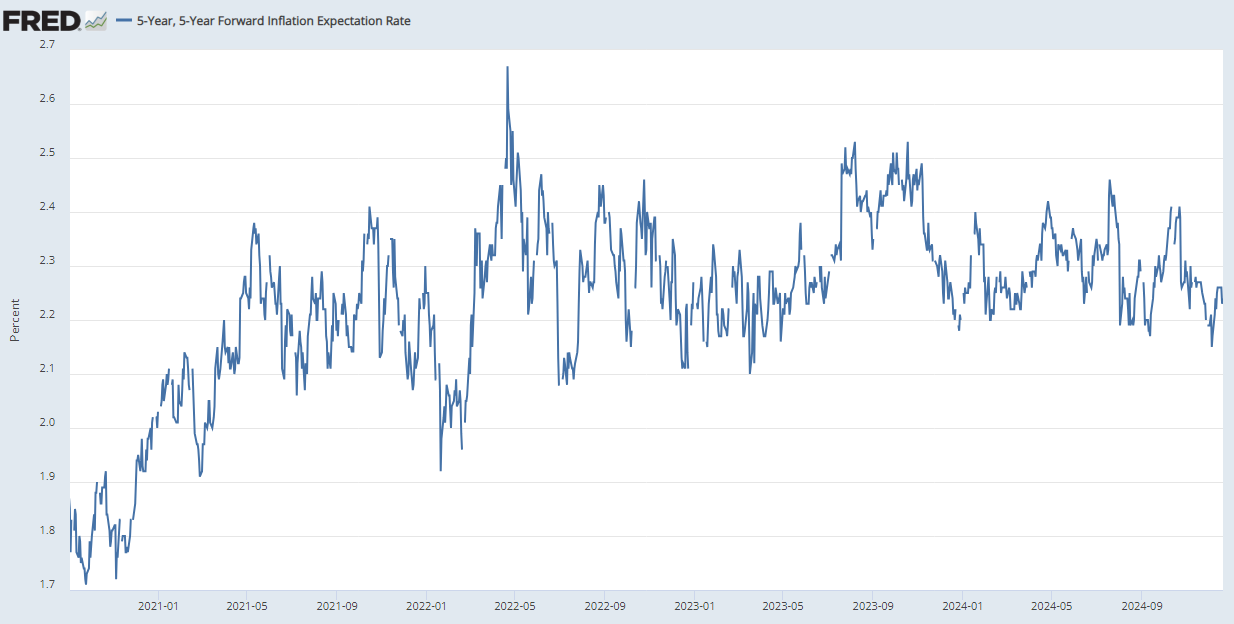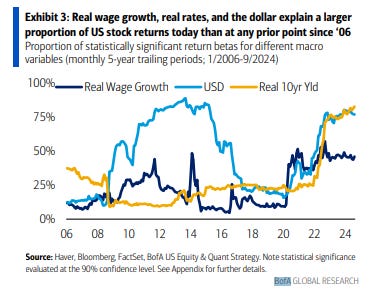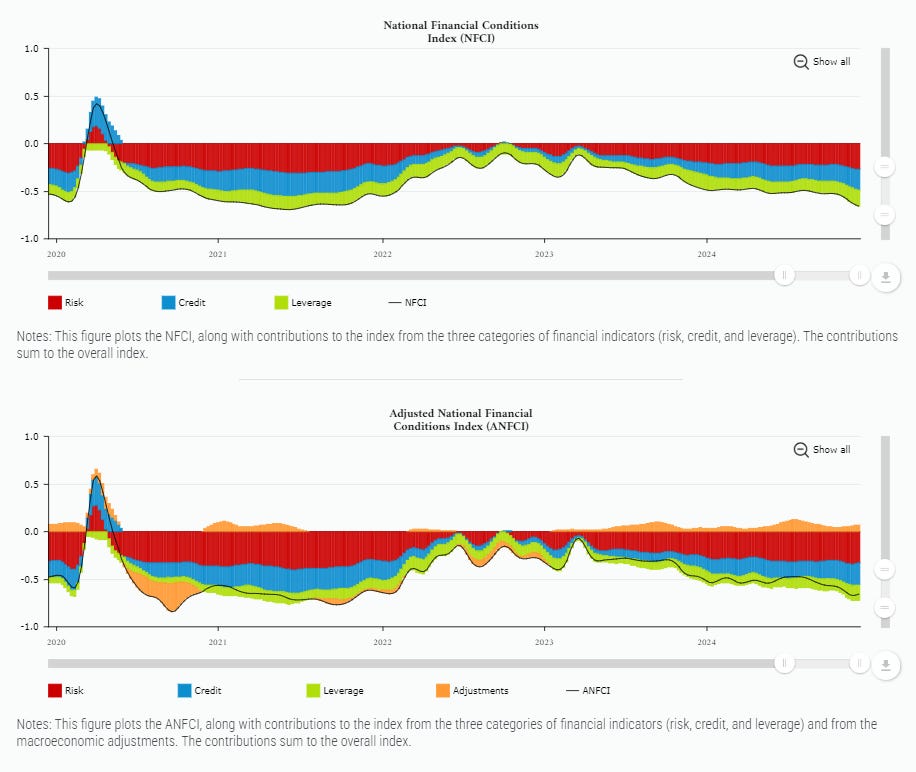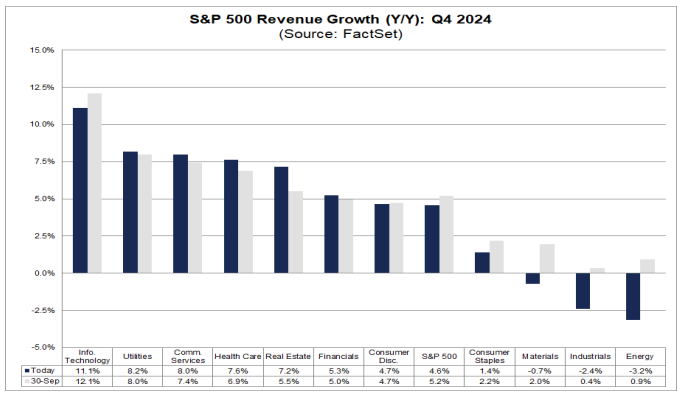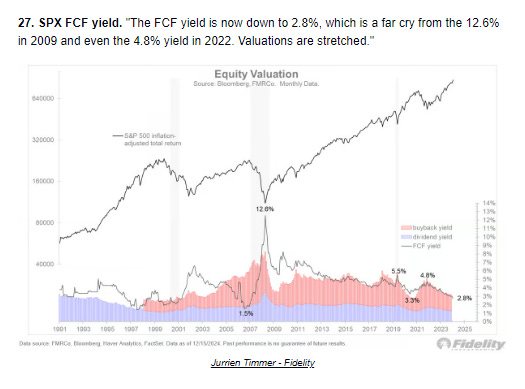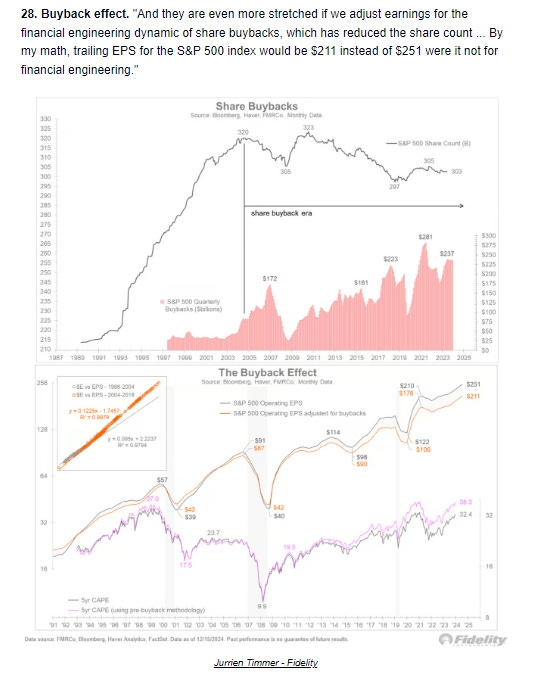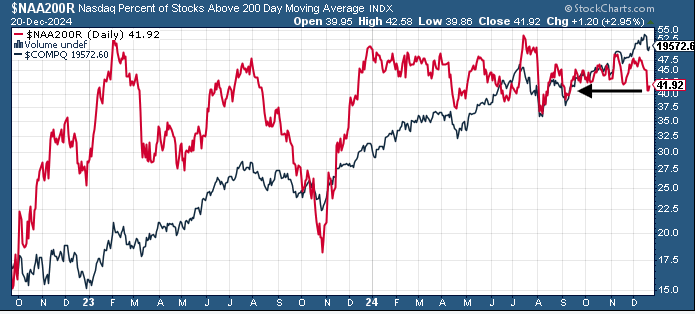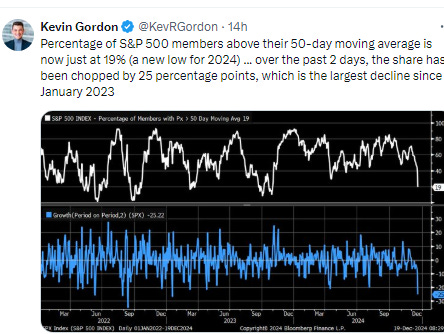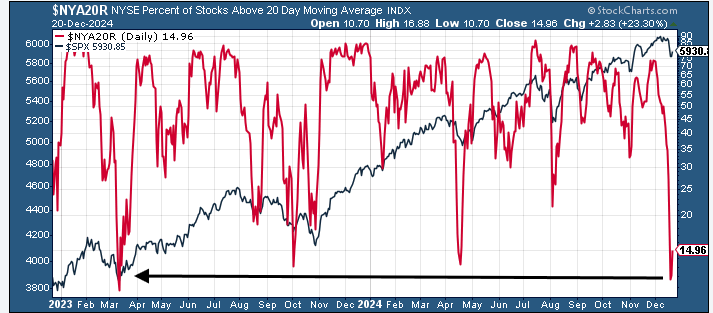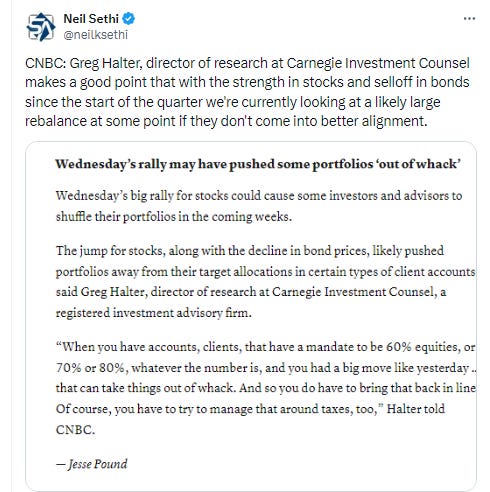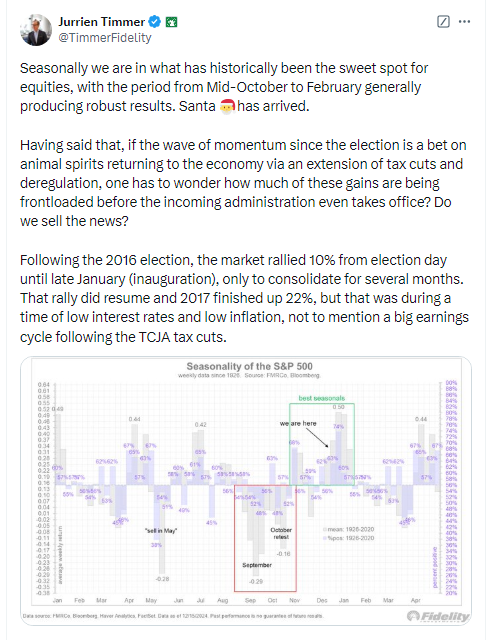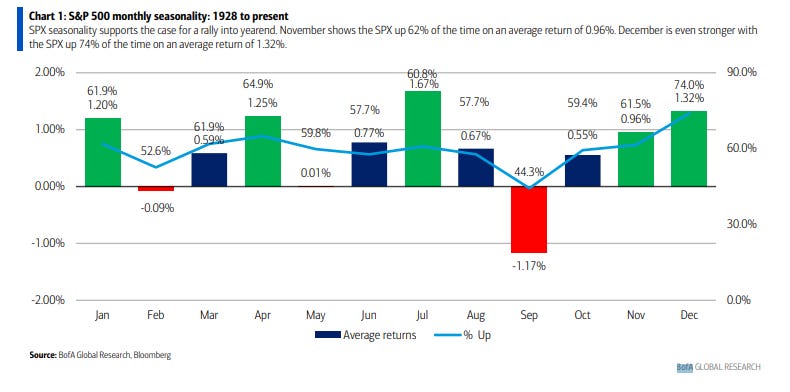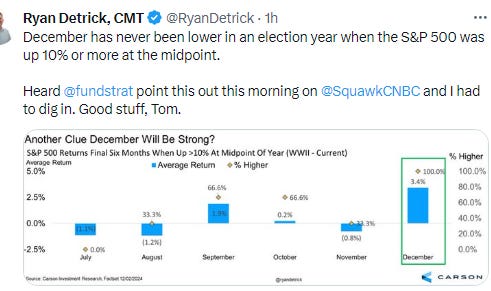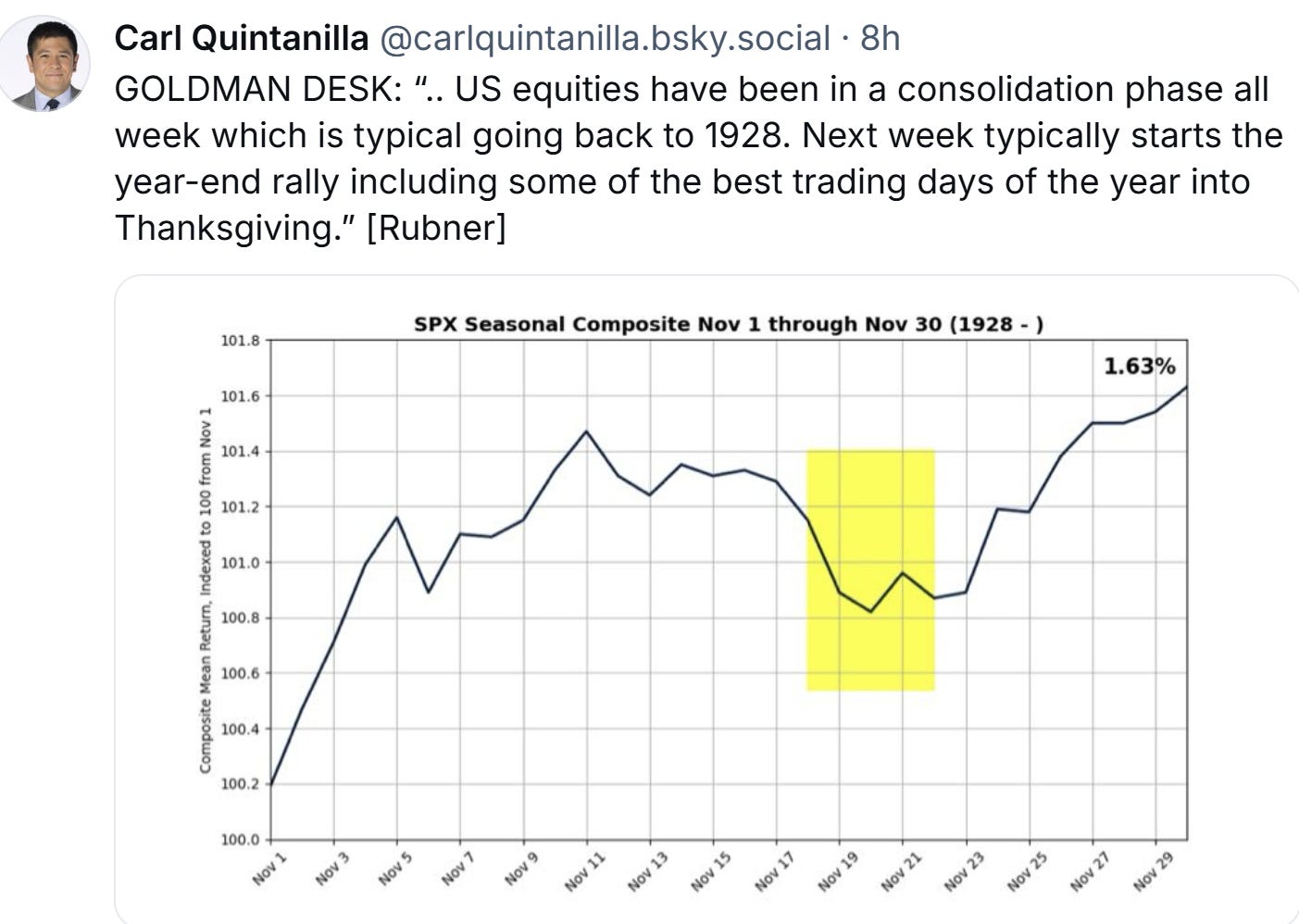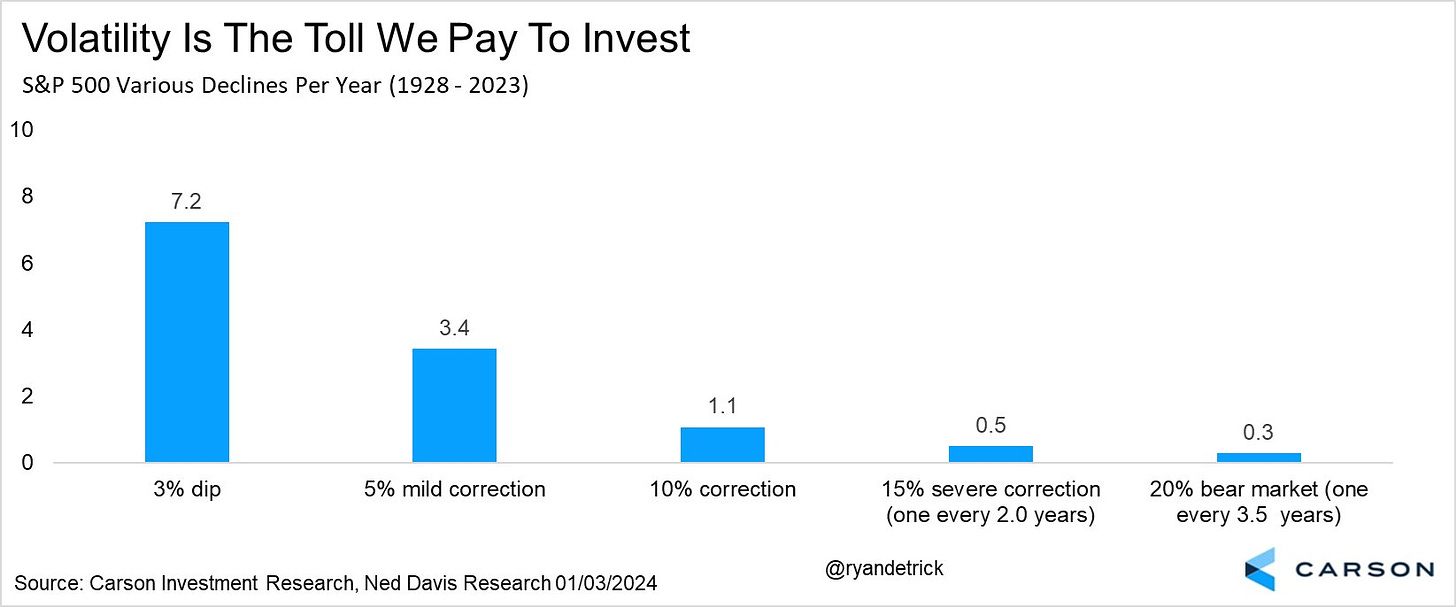The Week Ahead - 12/22/24
A comprehensive look at the upcoming week for US economics, equities and fixed income
If you're a new reader or maybe one who doesn’t make it to the end feel free to take a second to subscribe now (although then you’re missing my hard hitting analysis!). It’s free!
Or please take a moment to invite others who might be interested to check it out.
Also please note that I do often add to or tweak items after first publishing, so it’s always safest to read it from the website where it will have any updates.
As a reminder, some things I leave in from prior weeks for reference purposes, because it’s in-between updates, etc.. Anything not updated is in italics. As always apologize for typos, errors, etc., as there’s a lot here, and I don’t really have time to do a real double-check (and it’s a staff of 1).
NOTE NO DAILY UPDATE ON TUESDAY
As an aside for anyone worried that AI is going to take over the world, I tried to have this image done probably a dozen times to get the headphones/earmuffs off of Santa, and ChatGTP couldn’t do it (because of its protocols it can’t “reuse” prior information and has to do the image from scratch each time).
The Week Ahead
I said last week “it may be mid-December, but you’ll have to wait one more week before getting into the holiday groove,” and that definitely proved accurate, but now that week is behind us, and we can now settle in to a more traditional late December feel (at least in terms of economic catalysts) with a relatively sparse data calendar the next two weeks which are both cut in half by holidays, giving quite a bit of incentive for traders to take one (or both) weeks off. Expect light volumes and lots of “out of office replies”. Note that US markets close early on Tuesday (1pm for stocks, 2pm for bonds).
In terms of the data, the BEA cleared the decks of major data releases by moving the personal income and spending report well ahead of its normal schedule of near the end of the month to Friday, leaving us with just some “second level” data in Dec Conference Board consumer confidence and Nov new home sales, Chicago Fed National Activity Index, durable goods orders, and goods trade balance and inventories in addition to the normal weekly reports (jobless claims, mortgage applications, and EIA petroleum inventories).
I haven’t found any indications of any Fed speakers for this week.
US Treasury auctions will be one thing that picks up a full schedule of 2’s, 5’s & 7yr notes ($69, $70, & $44bn on Monday, Tuesday, and Thursday respectively). With the bond markets closing early Tuesday, I’d imagine that auction will be moved to 11am ET as it was pre-Thanksgiving.
Earnings reports are as light as they come with just a couple of reports on Monday, no SPX components.
Finally, it’s the week after a big options expiration which can see some volatility (in either direction) as a lot of “gamma” was released (as discussed in the Flows section), so markets will be freer to move (plus it will be into thin volumes with the holidays so things could be more volatile than many expect).
From Seeking Alpha (links are to their website, see the full earnings calendar):
The earnings season’s wind down is nearly complete, with no major companies due to report quarter results next week.
Ex-US a very light week as well. BBG didn’t do a weekly update like they normally do, but I looked through their economic calendar (link below) and they’ve got Canada Oct GDP, Dec Japan Tokyo & Mexico CPI, BoJ meeting minutes, and Japan Nov industrial production & retail sales (among other reports). Note much of the world takes both Tuesday and Wednesday off while Europe, Canada, and Australia also take off Thursday (wish we did that in the states).
https://www.bloomberg.com/markets/economic-calendar?sref=E10pTi1i
And here’s BoA’s cheat sheets. As I noted last week, it looks like that was their last one all the way through Jan 10th, so I included just this week (and will update in future weeks w/the data for that week).
And here’s calendars of 2024/2025 major central bank meetings.
Market Drivers
So let’s go through the list of items that I think are most important to the direction of equity markets:
Fed/Bonds
As noted previously this was one of the sections that had grown unwieldy, so I’ve really pared it down. Given I provide daily updates on Fed expectations, Fedspeak, and analyst thoughts on the Fed, it’s duplicative (and time consuming) to gather it all again so, again, I encourage you to look at those (the daily posts) for updates. I will just give more of a quick summary.
To give some background, I noted five weeks ago that
with the overall more hawkish Fed speakers including Powell, I think what is being telegraphed is a switch to quarterly cuts following what remains a likely December cut. I think the only thing that would change that is a strong November payrolls report and hotter than expected CPI (which comes during the blackout period so would need to be telegraphed by a Nick Timiraos/Colby Smith article(s)). But I do think if we get those types of reports the December cut is in serious jeopardy. For now, though, we wait.
And two weeks ago we got the first of those two key ingredients in the Nov payrolls report which, as I noted
while it showed stronger than expected payroll and wage growth, had plenty of caveats, the most important of which was the unemployment rate ticking higher and almost matching a 3-yr high as the household survey showed a second month of large job losses. We also saw a drop in participation, weaker than expected growth in private payrolls, and plenty of other negatives that markets seized on to bring the chances of a December rate cut to around 90%. That gives CPI a fairly high bar to push that down to even 50/50 (it would need to come in way above expectations), likely meaning that if following CPI Powell feels he doesn’t for sure have the backing for a cut at the meeting we’ll likely get another “we’re not sure” missive from the media as we saw last month as he does not like to surprise markets. Of course if the markets do that on their own it won’t be necessary, and CPI could come in as expected (or even better below expectations) which would almost certainly secure a December rate cut. There’s no use going through all the hypotheticals now, so I’ll revisit things next week when we have that print in hand.
And last week,
now we have that [CPI] print in hand, as well as the market reaction, and as noted in the Wednesday update, it “sealed a December rate cut by the Fed next week,” but also showed “core inflation remaining well above the Fed’s 2% goal, which all things equal will result in a slower pace of rate cuts than markets were expecting a couple of months ago and raising concerns of a prolonged pause if it continues to show little progress.” In that regard, as I’ve mentioned previously, I foresee what’s being described as a “hawkish cut” by some meaning a pivot to quarterly cuts after December, a reduction in the number of expected 2025 cuts, and some recognition that the endpoint is likely above 3%. Still with the Fed remaining uber-data dependent, Powell will not do much else I don’t think beyond setting expectations that January will likely be a pause. Markets already expect that with just a 25% pricing for a cut (assuming a December cut), so it shouldn’t really cause any sort of market issues.
And the strange thing is, I mostly got that right in terms of what happened, but my prediction on the market reaction was certainly not. First, while I foresaw a reduction in 2025 cuts, as I noted in the daily updates, I did think the market might not like it if they went all the way to two, which is what happened. Second, I think Powell “oversold” the slower pace a bit and confused things with his talk about “exiting the recalibration phase” and a “more traditional Fed posture” even as he talked about rates still being “restrictive” and that “we and most other forecasters still feel that we're on track to -- to get down to 2 percent it might take another year or two from here, but I'm confident that that's the path we're on.”
That implies that rates will continue to be cut towards what the committee (on balance) feels is a terminal rate in the 3’s not the 4’s, “it might just take another year or two”. Markets though are saying we might get one or two more cuts, and that’s it. So there’s clearly a disconnect there, and it’s one that we have seen time and time again the last few years. Markets extrapolate recent trends too far (they were expecting 5 cuts in 2025 not too long ago), and I think this may be one of those cases.
That said, just a few cuts before a prolonged hold would be consistent with the 90’s “soft landing” experience, and it’s certainly not implausible that inflation gets “stuck” around current levels and growth and labor markets remain in good enough shape keeping the Fed to just one or two (or I guess no) cuts in 2025, but I think it’s also not unlikely that we see continued softening in labor markets and the economy, and with just 18% of investors expecting a recession in 2025, it feels like a growth scare and a quicker path of Fed rate cuts is underpriced.
Looking at the Treasury markets, with yields rising more on the long end again last week, the 2/10 curve steepened another 7bps w/w to +0.22% Fri according to the St. Louis Fed, the highest since the recent peak (+0.26%) in Sept (which it did exceed intraday on Thursday before settling back). I had said last week “this should steepen further following the FOMC meeting I think,” and we actually got the most steeping this year, so we’ll see if that continues.
As a reminder, historically when the 2/10 curve uninverts following a long period of inversion the economy is either in a recession or within a few months of one. Given we just got a 2.8% GDP for 3Q and are currently estimating well over 2% for 4Q, it seems like the days of the 2/10 curve as an infallible recession indicator may be numbered.
The 3mos/10yr yield curve (considered a better recession signal than 2/10’s w/the last four recessions on average coming a few months after the curve uninverted (prior to that it generally uninverted after a recession had already started)) continued its dramatic resteepening since late Sept +12bps w/w after moving into positive territory last week for the 1st time since Oct ‘22 to +0.18% (up +1.31% since Sept 11th).
Long term inflation expectations (as measured by the 5-yr, 5-yr forward rate (exp'd inflation starting in 5 yrs over the following 5 yrs), specifically mentioned by Powell at the Nov FOMC press conference (he said the metric was “right where it’s been, consistent with 2% PCE inflation”), fell back to 2.24% on Thursday (-2bps w/w and -5bps since the Nov FOMC).
With inflation exp's falling and 10yr nominal Treasury yields rising sharply, 10yr real rates using 10yr TIPS shot up +28bps to +2.28%, the joint highest (w/April) this yr & remaining well above the 2010-2020 peak of 1% (but down from the post-pandemic peak Oct ‘23 of 2.5%).
10yr real rates using 5-yr, 5-yr forward inflation expectations (subtracted from the 10yr nominal yield) jumped as well +22bps to 2.29%, the highest since Nov ‘23, also well above the 2013-2020 average of around 0.5% (but down from the post-pandemic peak of 2.5% in October '23).
And as a reminder according to BoA the importance of real rates on equity returns has seen the largest increase in the factors they track over the past 5 yrs and explains a larger proportion of stock returns (83% correlation) in their data (to 2006), with the dollar close behind the most correlated (76%) since 2015.
Shorter-term real yields (Fed Funds - core PCE) fell this week with the rate cut to 1.82%, the least since Sep ‘23 and down from 2.70% in June (which was the highest since 2007), but still well above anytime in the 2010-2020 period.
And the real prime rate (using core PCE) continues to edge lower from the 5.9% in June, which was the highest since Sep 2007. Now down -90bps at 5.0%, still though more than double the 10yr pre-pandemic avg.
And the gap between 2yr Treasury yields and Fed Funds has now closed (-42bps w/w) after being at a record wide 1.77% before the Sept FOMC meeting. It is implying that there will be no further rate cuts over the next 2 years. As I said last week, “ I’ll bet the under on that.” I have been buying 2 years this week.
And looking out longer term, one thing to note is the FOMC’s long run projection for the endpoint of the Fed Funds rate (the “neutral rate”) is now the highest since Sep 2018 at 3.0% (and not unlikely to go higher as I said earlier this yr). [This won’t get updated again until March].
For some reason the St. Louis Fed is not updating their 10yr term premium estimate until the following week, so I’ve switched to a different one from MacroMicro which uses a different model (ACM model) which is solely based on interest rates. That hit +0.44% this week +27bps w/w and matching the Oct high which was the highest since 2015. It’s now +55bps since the FOMC did the 50bps cut in Sept.
I had been a broken record since the Spring that I thought at some point (most likely around the election) this could resurface as an issue that will push yields higher perhaps cause some mild equity indigestion as it did in Oct of last yr. I thought maybe the issue had past with the market continuing to grind higher, but now it seems we’re getting some of that.
https://en.macromicro.me/charts/45452/us-10-treasury-term-premium
The extended discussion on term premium (what it is, why it’s important, etc.), can be found in this section in the Feb 4th Week Ahead.
As the MOVE index of expected 30-day bond volatility moved off the least since Feb 2022 but remains relatively low considering the jump in 10yr yields this week.
And while bond volatility edged higher, 30yr mortgage spreads fell -11bps to 2.2%, to the least since June ‘22, they remain though around +65 bps above the 2010-2020 avg level.
Chicago Fed National Financial Conditions Index its adjusted counterpart (which are very comprehensive each w/105 indicators) saw the former fall this week to the least since July ‘21 but its adjusted counterpart (which attempts to remove the correlation between the various indicators due to economic conditions) edged higher from the loosest since Nov ‘21. Note though this was in week through Dec 13th so didn’t capture the dramatic move in real yields (although the move we’ve seen since Sept hasn’t seemed to matter much).
https://www.chicagofed.org/research/data/nfci/current-data
Looking at the Fed’s balance sheet/QT, we continue to see liquidity drained from the system. The most visible area has been in reverse repos (which is an overnight secured place institutions (mostly money markets and banks) can park excess funds to accrue some interest designed by the Fed originally to keep excess liquidity from pulling down rates too much in other short term markets). RRP has been steadily drained as money has been redirected to purchase the continued sizeable issuance of T-bills (<1 yr duration) of around $800bn/month (accentuated by the $60bn in balance sheet runoff (meaning the Fed has reduced its buying of maturing Treasuries by that amount which the private market has to fill)) which quickly drained ~$1.75 trillion from RRP in the year through March 1st. From then until early July RRP levels had remained relatively stable in the $375-$500bn range, but since early July they resumed their decline (in fits and starts), now hitting new lows.
With the Fed now cutting RRP rates to the low end of the Fed Funds band, it has made parking funds there (versus lending overnight to other institutions or buying T-Bills) less attractive meaning we’re likely to see RRP continue to fall to whatever is the “minimum” level (some participants will use it just due to ease of use, etc.).
In that regard, RRP fell under $100bn for the 1st time since April ‘21, meaning at this point the Fed has “sopped up” most of that “excess liquidity” (as they have described it). We normally see this spike higher into quarter-end but so far not seeing that (and that is the Fed’s goal in reducing the rate (to make it more attractive for money markets, etc., to provide funding for other areas that need it at YE).
As noted previously, despite this drawdown Dallas Fed Pres Laurie Logan (who is an important voice given her extensive experience in the NY Fed's markets group) like Powell believes current liquidity is “more than ample” and said she's looking for RRP to fall to "negligible" levels. As I said then “she's the expert so I'll defer to her, but I continue to be on the lookout for funding stresses now that RRP has crossed below $100bn, and I still think at zero RRP the Fed may need to stop QT to avoid another liquidity shortage as they did in late 2018.” We’re getting there quickly (although this may spike as we get into quarter-end as we’ve seen every quarter the past year).
And as noted previously, BoA, who had previously estimated that RRP would fall to zero in Oct has pushed that out now to Jan ‘25. For more on BoA’s forecasts for RRP to drop to near zero ($60bn) by Oct you can follow the link and look in this section (but it’s mostly due to RRP yields falling below those of money markets and will be soaked up by bonds (from Fed QT), the Treasury (with a higher TGA), and currency growth (in dollars). If bank reserves increase that would also pull from RRP. They see it building again into early 2025 before declining again towards zero.
For more on BoA pushing back their est for the end of QT to Mar ‘25 from YE ‘24 “which could create a funding blind spot for the Fed” in the event the debt limit (which expires at YE) is not resolved you can follow this link and look in this section. In summary their thinking is that, similar to earlier this year, the Treasury’s depletion of its General Account (TGA) will offset what would otherwise be a continued drawdown of liquidity. That will keep liquidity stable but will rapidly reverse once the debt limit is ultimately raised (which BoA est’s will again be in July as they assume Congress will take it to the very last second as is their habit), which could lead to a funding squeeze. However if the debt limit is raised in advance, the liquidity issue will come quickly as noted above, and we could very easily find ourselves in another 2018 scenario (which resulted in a near bear market).
Also pulling out liquidity from the system has been the repayment of BTFP loans as the Fed looks to wind down that facility by YE. Those have gone from a high of $167bn in March to now just $13bn.
The use of RRP to fund other areas (T-Bill auctions, BTFP payback, etc.) has allowed bank reserves to remain at healthy levels around the highest since Sept 11th in the week through Wed at $3.24tn, -$30bn w/w, leaving them with some breathing room from the $3tn level which we haven’t revisited since the indigestion in the credit markets in March ‘23 (which contributed to the banking issues (SVB, etc.)).
Overall, they remain just -$112bn below June 1, 2022 levels ($3.36tn), when the Fed started QT, a much better result than even the most optimistic estimates at the time.
For background on various estimates of when reserves will be “too low” see the Feb 4th Week Ahead.
Getting back to rates, I said 8 months ago 2-year Treasuries were a good buy at 5%, and as I noted once the Fed started its cutting cycle the ship has likely sailed on seeing those yields anytime soon (meaning years). In terms of 10’s I had advised then grabbing some at 4.7% which I had thought seemed like something we wouldn’t see anytime soon, but as I noted five weeks ago “we’re already back to 4.45% and 4.7% doesn’t seem so far away. I still think it will take something ‘new’ to push over 4.5% (a hot inflation print, very strong payrolls report, etc.), but we’ll see.”
Well, the Fed saying the “recalibration phase has ended” was certainly something “new,” and as expected it, along with concerns about sticky inflation cropping back up, has seen rates back over 4.5%. From here 4.7% seems not unlikely, although I still am not sure we see 5% absent the Fed becoming even more aggressive (likely due to Dec’s data coming in hot (payrolls and CPI/PCE prices). In terms of much lower yields, as I said 11 weeks ago, we have probably seen the lows until we get a recession:
“while we didn’t quite see 3.5%, I think 3.6% is close enough, and I think we might have been at or near the lows at this point, particularly as the Fed has been raising their neutral rate estimate. If the endpoint for Fed Funds is around 3% (or higher) then it’s hard to see the 10yr trading much lower absent a recession. Similarly 2yrs at 3.6% seem to be very rich and almost certainly too low absent a recession consistent with my statement last week.” In short I’d expect to see 4% on these before we see 3.2%:
At around 3.6% on both the 2 & 10yrs absent a recession I think there’s not much value in either (I’d rather park my cash in short term Treasuries (0-3mths) or safe dividend paying stocks with a track record of growth (dividend aristocrats, etc.) at these levels.
At this point I have started to dip my toes back in as noted above, given it’s now pricing no further net cuts from the Fed over the next 2 years. I will step up my buying of 10yrs if they get to 4.7%.
For all the old “final hike” and “first cut” materials, you can reference the Feb 4th blog post.
BoA updated their FOMC Dove-Hawk Chart. Note it’s missing Hammack in ‘26 (Cleveland and Chicago vote every 2 yrs), but otherwise looks right. Also note that Philadelphia Fed Pres' Harker’s term is up next year (which is why they don’t have a name for Philadelphia), something I didn't realize.
Also, I had a little back & forth with them arguing that Schmid should be "Hawkish" considering that he didn't dissent (versus Bowman) and that Goolsbee seemed more dovish than Harker. Here was their response (which makes some sense):
In a recent dot plot (I think June), Goolsbee identified himself as not the outlier, which led us to conclude Harker is the outlier. On the other end of the spectrum, there were two people forecasting 50bp of total cuts this year. We think they’re probably Bowman and Schmid. If we had more granularity, we’d rate Bowman as more hawkish, but with only five categories, I’m comfortable with putting them in the same bucket.
I think this now needs some dramatic changes with Hammack (who dissented voting for no cut in Dec) clearly one of the most hawkish members, Daly at best a Centrist as she sees only 2 cuts in 2025, and perhaps Collins as well. Goolsbee is clearly the most dovish of the members currently.
And I came across one from BBG. I think it’s pretty accurate except Kashkari is definitely not that hawkish (he was calling for a December cut in early November):
Earnings
As a reminder, I have removed most of the background material, which you can get in the Feb 4th blog post. As you know I’ve moved on to 4Q and beyond. You can reference this post from 12/1/24 for stats on 3Q.
Note Factset provided an abbreviated update this week, so anything not updated remains in italics. Also not many charts.
Expectations for Q4 earnings improved a tenth this week to +11.9% (still down -2.6% since the start of the quarter, slightly less than the 5 & 10yr avgs (-3.4% & -3.3%) for this period). 11.9% would be the most growth in three years and would mark the 6th consec quarter of earnings growth.
Looking more specifically at Q4, according to Factset, just 5 industries are responsible for most of the 12% in exp'd earnings growth in Q4: Banks (181% exp'd growth), Semiconductors & Semiconductor Equipment (34%), Pharmaceuticals (64%), Interactive Media & Services (25%), and Broadline Retail (48%). "Excluding these five industries, the estimated earnings growth rate for the S&P 500 for the fourth quarter would fall to 1.6% from 12.0%."
In terms of Q4 revenues, SPX co’s are expected to see revenue growth of 4.6% y/y (down two tenths w/w), down from +5.2% on Sept 30. It would mark the 17th consecutive quarter of revenue growth for the index.
In terms of profit margins, co’s are expected to report net profit margin of 12.0% for Q4, which is below the previous quarter’s net profit margin of 12.2%, but above the year-ago net profit margin of 11.2% and the 5-year average of 11.6%.
2025 quarter-by-quarter earnings expectations were mixed this week with some 1H earnings getting pushed later or just priced out. Q1 ‘25 fell seven tenths to +12.1% (-2.0% last 7 wks) & Q2 ‘25 also seven tenths to +11.4% (-1.9% last 7 wks). Q3 was up four tenths to +15.6%, but Q4 edged two tenths lower to +16.7%
The lower Q4 earnings expectations saw FY ‘24 exp's edge down a few cents to $239.92 (still +57 cents above the low 3 weeks ago), still representing +9.5% growth. Looking further back, it remains down just around -2% from July 1, 2023, much better than the typical -6% or so drop we historically see.
2025 earnings expectations also fell for the 1st wk in four a larger -9 cents to $275.15 (still +15.0% growth), up +56 cents from low 4 wks ago which was the least since February.
In terms of the $275.24 exp’d for 2025 Factset notes it will be a record although also notes that there is on average over the past 25 yrs a -6.3% deterioration from where it starts the year (so Jan 1, 2025) w/analysts overestimating in 17 of those yrs. But it should be noted that average includes 4 outlier years (2001, 2008, 2009 & 2020) where the overestimation was b/w 27-43% due to recessions. Excluding those, the difference is just -1.1%.
Factset also notes that “"analysts believe earnings growth for companies outside the 'Magnificent 7' will improve significantly in 2025. While analysts expect the 'Magnificent 7' companies to report earnings growth of 21% in 2025, they expect the other 493 companies to report earnings growth of 13%...a substantial improvement to ...just over 4% earnings growth for these same companies for CY 2024."
In terms of exp’d 2025 revenues, analysts are looking for 5.8%, above the 10-year average of 5.1% (2014 – 2023). Ten of the eleven sectors are projected to report year-over-year growth in revenues, led by the Information Technology sector. The Energy sector is the only sector expected to report a year-over-year decline in earnings.
They also see at a record profit margins at 13%, well above the 10-yr average of 10.8% and the highest since Factset started tracking the metric in 2008 (previous high was 12.6% in 2021).
In terms of how markets are handled earnings beats & misses for 3Q, looking 2 days before to 2 days after an earnings release, Factset saw beats rewarded more than average at +1.6% vs 5yr avg of +1%, and misses punished more than average (-3.1% vs 5yr avg of -2.3%).
Factset’s analysis of analyst bottom-up SPX price targets for the next 12 months as of Thursday was up another 56pts w/w to 6,678, now up ~1,655 points over the past 39 weeks. Health Care remains with the largest upside seen by analysts (+19.7% (up from +17.5% last wk and +13.1% 3 wks ago before the “Kennedy” selloff)) followed by Materials (+16.8%), and Energy (+16.7%), while Consumer Discr remains as the sector expected to see the smallest price increase (-3.3%, the first negative we’ve seen this year).
As a reminder the last 20 yrs they have been on avg +6.9% too high, but note they underestimated it five of the past six years (including 2024 unless the SPX crashes).
In terms of analyst ratings, buy and hold ratings continue to dominate at 54% & 40.1% (from 53.7 & 40.1% respectively last wk (sell ratings fell eight tenths to 5.1%)). That 54% though is down from 57.5% in Feb ‘22.
Communication Services (61%), Energy (61%), and Information Technology (61%) sectors have the highest percentages of Buy ratings, while Consumer Staples (41%) and Utilities (48%) have the lowest percentages of Buy ratings. Financials, Industrials, and Utilities have the most sell ratings (8%).
And some other earnings stuff:
Economy
Over the past 2+ years part of my earnings optimism has been due to the economy holding up better than expected. While earnings only track the economy loosely (and markets look forward 6-12 months), there is a clear correlation between recessions, lower earnings, and lower stock prices (although stock prices (being as noted forward looking) generally fall in advance of the recession and bottom 6-9 months before the end of the recession). So if you can see a recession coming it is helpful, although very difficult (especially ahead of the market). You can reference this Week Ahead (see the Economy section) for a lot of material on how every recession is preceded by talk of a “soft landing” as close as a month before the start. On the IRA infrastructure act, the November 26 report has good info on how that should be supportive at least through the end of this year. That report also has the notes about how small caps have shorter debt maturity profiles and more of it.
As I’ve been stating since I switched to the Week Ahead posts in mid-2022, the indicators to me are consistent with solid (which at times has been robust) economic growth, and I have been a broken record that I “certainly [did] not think we’re on the verge of a recession (although as noted above every recession starts out looking like just some economic softening).” But several months ago I added: “That said, I’ve also noted over the past __ weeks or so [it got to 22], we have clearly started to see some moderation in key areas like consumption, manufacturing, construction, exports and housing.” Following that was a stretch of 10 weeks were I changed that to describe “the data [as] fairly strong, more consistent with what we’d been seeing at the start of the year.” That though took a turn 4 weeks ago with some weaker than expected data, although as I caveated some of it was impacted by hurricanes or strikes and others like GDP and personal spending while softening remained at robust levels.
We got a slew of data this week and most of it confirmed the above. Flash PMI’s showed a very strong services sector but continued weakness in manufacturing as did industrial production, retail sales and personal spending showed solid consumer spending as did the revision to 3Q GDP, housing starts showed continued subdued activity there but existing home sales were the best in 3 years, the leading indicators saw their first positive read in nearly 2 years, and real (inflation adj’d) wage growth in the personal income data was the best since February. So as I’ve noted the last three weeks “what I can say with confidence is all of this evidences an economy that is slowing from elevated levels but continues to grow at or above trend.”
In that regard I don’t really see any changes to my overall takeaway on the economy from 12 weeks ago, “the situation continues to seem like manufacturing is subdued but trying to bottom, housing perhaps has inflected off the bottom [although that has softened of late with the jump in mortgage rates (although perhaps now buyers have become “used to” higher interest rates)], labor markets (and the services sector and construction in particular) are solid [although it seems there might be some slowing from elevated levels] with very healthy wage growth, and productivity appears to be robust (something I think you’re going to be hearing more and more about)…I continue to feel that any softening does not appear to be morphing into a recession.”
And as I said 17 weeks ago:
without question, the evidence is building that the days of >3% real GDP growth are behind us (although we got there in Q3), and we should be happy to settle into something more around trend (1-3% real (infl adjusted) growth). That though is far from a disaster. The important thing will be to see the softening level out (L-shape) rather than continue to fall turning the “soft landing” into a recession.
So far that’s what we’ve seen.
The Citi Economic Surprise Index though fell for a 4th week to the least since October 24th at 20.1, now down -23.2 pts from 43.3 four weeks ago, still for now closer to the highs of the year (47.2 in Feb) than the lows (-47.5 in July).
And GDP estimates are for now consistent with a no recession call (again though remembering GDP going into recessions generally doesn’t look like one is coming (it was up around 2% in Q2 & Q3 2008 well after the recession had started)). After Q3 was revised up this week to 3.1%, trackers are a bit all over the place but mostly in agreement that we should see around 2% (trend) GDP growth again in Q4 (although they are as low as St Louis Fed’s +1.16% (which is generally too low) to as high as +3.1% from the Atlanta Fed (who has been pretty accurate, but jumps around a lot).
Goldman (who was 3.0% for 3Q vs 2.8% actual 1st est) still had their 4Q GDP estimate at +2.4% the last I saw.
Atlanta Fed (who was right in line in its 3Q est of #GDP (and just a tenth off for 2Q from the 1st est)), saw its 4Q GDP estimate edge down to +3.1%.
BoA (who as a reminder est’d 3.0% for 3Q vs 2.8% actual), didn’t update their 4Q GDP tracking this week. Last week it was at 2.1%. Their “official” house est is 2.0% y/y growth in 4Q.
NY Fed’s 4Q GDP Nowcast (as a reminder, they had 2.91% for 3Q vs 2.8% 1st est) improved this wk to 1.90% from 1.85%. As a reminder, the NY Fed’s model is dynamic and so adjusts in real time as data evolves, and there was a small negative “parameter revision” this wk.
They lowered their Q1 ‘25 GDP forecast to 2.13% from 2.29%, but as it was all due to the Philly & NY Fed regional activity indices, I would fade it (they are extremely volatile).
And the St. Louis Fed GDP tracker, which outside of Q1 this yr (where it was the closest) has undershot actual real GDP since Q3 ‘22, continues to see sub-2% growth falling back to 1.14% for Q4 continuing the pattern of lagging all the other GDP trackers.
Weekly Econ Index from the DallasFed (scaled as y/y rise for GDP), which runs a week behind other GDP trackers, remains a little jumpy, now up to 2.70% in the week through Dec 15th from 2.16% the prior week (revised slightly +2.15% ) putting it back above its range this yr (1.49 - 2.66% for only the second time (it hit 3.21% a few weeks ago)). The 13-wk avg moved to 2.14%, evidencing overall economic momentum slightly above trend.
https://www.dallasfed.org/research/wei
Other economy stuff:
Valuations
Like the other sections, I’ll just post current week items regarding the multiple. For the historical stuff, see the Feb 4th blog post.
With equity indices falling this week, forward P/E’s did as well.
-The SPX forward P/E fell five tenths to 21.6 (down now seven tenths the last two weeks from the highest since mid-'21).
-Mid-caps (S&P 400) fell eight tenths to 15.8 (down now -1.3pts the last three weeks from the highest since early-’21 (17.1)).
-Small caps (S&P 600) were down nine tenths to 15.6 (down now -1.5pts the last three weeks from the highest since early-’21 (17.1)).
-Yardeni's “Megacap-8” P/E down two tenths to 30.7, still up +4.3 pts from the 26.4 it hit 13 weeks ago (which was the least of the yr) and not far from the 31.5 it hit 21 wks ago (which was the highest since Jan ‘22)).
https://yardeni.com/charts/stock-market-p-e-ratios/
Other valuation stuff:
Breadth
If you don’t know breadth has been atrocious then you haven’t been paying much attention. You should skim the daily updates from time to time.
The McClellan Summation Index ("what the avg stock is doing") down to the least since Nov ‘23 with no indications of a turn upwards yet.
% of stocks over 200-DMAs fell sharply this week hitting the least since Nov ‘23 on the NYSE and least since Aug on the Nasdaq.
% of stocks above 50-DMAs, similar to those over 200-DMAs, fell to the least since Nov on the NYSE and since Aug on Nasdaq.
% of stocks above 20-DMAs continued to fall back more sharply than those over 200 & 50-DMAs w/NYSE hitting least since Mar ‘23 and Nasdaq closer to the Aug lows.
Value/Growth fell sharply for a 3rd week now the least since Jan ‘22. To say as I did 3 weeks ago that “we’re not seeing the dramatic jump we got following Trump’s victory in 2016,” was I said last week “a huge understatement” so I don’t even know what to call it this week. As I said last week, “what we’re seeing now looks more like the action we saw in 2017 when the ratio fell through Trump’s first term until it finally bottomed post-Covid.”
The equal-weighted SPX vs cap weighted ratio like value/growth fell sharply last week to the least since July (which was near all-time lows). Like value/growth this is the opposite of what we saw immediately following Trump’s victory in 2016, and, again like value/growth, more like what we saw in 2017 when the ratio fell throughout Trump’s 1st term until it finally bottomed post-Covid.
It also is starting to deviate too much from the 2009 pattern where we saw an initial bounce from historic lows, then a pullback for several months before it embarked on a rapid multi-year recovery for me to say “it bears some resemblance”, consistent with my comment post election that “the Trump analog raises caution signs.”
IWM:SPY (small caps to large caps), fell back to the lowest since July (which were 24yr lows). Like value/growth and equal-weighted/cap-weighted we haven’t seen the same kind of post-election bump we did in 2016. Unlike those, though, the ratio didn’t really start falling until mid-2018 but is no longer holding up better this time around.
Equity sector breadth based on CME Indices last week was poor with every sector down (was it just 3 weeks ago we had 10 sectors up?). Megacap growth sectors outperformed taking two of the top three spots but 10 of 11 sectors were down at least -1.5% (w/9 over -2%).
SPX sector flag from Finviz consistent w/again lots (and lots) of red outside of just a few names (that’s the same sentence I wrote last week).
Other breadth stuff:
Flows/Positioning
BofA, using EPFR data in the week through Dec 18th, saw global equities with another inflow (12th in 13 weeks & 29th in 31 weeks), +$68.7bn, now +$219.6bn over the last 6 weeks (since the election) and +$738.9bn YTD:
US: 11th week of inflows, a record +$82.2bn (which BoA’s Hartnett things may be due to YE rebalance mechanics), bringing the 6-week total (since the election) to +$233.5bn, and +$544.2bn YTD, annualizing to a record $556bn.
EM: 3rd inflow, +$4.7bn, still -$20.5bn over the last 11 weeks, but +$155.8bn YTD (after +$91bn in all of ‘23). #China: Returned to outflows, -$1.7bn, YTD still +$134.4bn. #India: Small inflow, +$0.1bn, pushing the YTD total to +$20.6bn.
Japan: 5th straight outflow, -$1.1bn, bringing the 4-week total to -$10.7bn. YTD remains +$3.2bn, falling further below 2023’s +$7.3bn.
Europe: 12th straight outflow and 86th in 92 weeks, -$2.6bn, now -$66.4bn YTD after -$66.9bn in 2023.
US Large Caps: 11th consecutive inflow & 52nd in 62 weeks, +$77.8bn, now +$184.8bn over the last 6 weeks (since the election), ~+$262.8bn over the last 12 weeks, and ~+$550.8bn over the last 57 weeks, after +$125bn in all of 2023.
US Small Caps: 4th inflow, +$3.4bn, now +$31.7bn over the last 6 weeks, +$34.8bn over the last 23 weeks, and +$33.6bn YTD, annualizing to a record $36.5bn.
US Value: Returns to inflows, +$17.6bn, now -$54.4bn YTD, improving from last year’s record -$73bn in 2023.
US Growth: Returns to inflows, +$12.9bn, still -$30bn last 25 weeks but +$121bn YTD.
Sector-specific flows in EPFR data were mixed in the week through Dec 18th.
Inflows:
Financials: 7th consec inflow (longest streak since Feb ‘22), +$0.2bn, +$9.1bn over the last 6 weeks (since the election).
Materials: 14th inflow in 15 weeks, +$2.3bn, now +$25.8bn over the last 13 weeks.
Consumer: +$0.5bn, breaking a streak of outflows. Still -$26.6bn over the last 60 weeks.
Real Estate: returns to inflows, 8th in 10 wks, +$0.2bn, narrowing the decline to -$2.9bn since the election.
Comm Services: +$0.2bn.
Outflows:
Tech: Leads outflows for a 3rd week, -$1.8bn, still +$3.6bn over the last 5 weeks, +$16.1bn over the last 21 weeks, and +$50.6bn over the last 50 weeks.
Healthcare: 5th straight outflow, -$0.1bn, now -$4.6bn over the last 5 weeks and -$23.0bn over the last 62 weeks.
Financials: 1st outflow in 8 weeks, -$0.1bn, now +$9.0bn over the last 7 weeks (since the election).
Utilities: 2nd outflow, -$0.3bn, now -$1.3bn since the election.
Energy: Another outflow, -$0.8bn, the 17th in 19 weeks. Now -$9.6bn over the last 18 weeks and -$2.7bn since the election.
Comm Services: -$0.004bn, still +$0.2bn over the last 2 weeks.
Looking at EPFR data for the week through Dec 18th, global fixed income saw its first outflow in 52 weeks, -$6.0bn. YTD remains at ~$612bn (annualizing to $6bn):
IG/HG: Small inflow, +$0.2bn, marking the 60th consecutive inflow (& 86th in 88 weeks) and now ~+$403.2bn YTD, on track for a record $411bn in 2024 after +$162bn in 2023.
HY: Another outflow -$3.7bn, the 2nd outflow in 19 weeks. Still ~+$60.2bn over the last 57 weeks, YTD remains a record $52bn.
Munis: 1st outflow in 25 weeks (and only 5th in 48), -$1.4bn. Now +$2.2bn since the election.
US Treasuries: Another outflow (but only 9th in 34 weeks), -$1.7bn, now -$9.6bn since the election.
TIPS: Another inflow, +$0.2bn ($+0.5bn last 2 wks), just the 6th in the last 24 weeks and 12th in 69.
Bank Loans: 11th week of inflows, +$1.2bn, now +$14.6bn over the last 9 weeks.
EM Debt: 9th consecutive outflow, -$1.0bn, now -$15.1bn last 9 weeks.
In the week through Dec 18th, EPFR saw cash outflows accelerate to -$63.8bn, but YTD still +$1.049tn (annualizing to +$1.07tn, after a record +$1.3tn in 2023 and +$3.3tn from 2019–2023).
Gold/Silver: Returned to outflows, -$0.9bn, still +$12.1bn over the last 29 weeks, but -$3.6bn since the election.
Crypto (mostly #Bitcoin) another inflow, the 13th in 14 weeks, +$3.1bn, now +$22.1bn over the last 9 weeks, and +$17.6bn since the election, +$42.1bn YTD.
ICI data on money market flows saw a -$19.6bn outflow in the week through Dec 18th, less than vs EPFR’s -$64bn, and cutting a little into the YTD flows which are still ~+$865bn with total MMF assets at $6.75tn, just off the record high of $6.77tn. All of the outflow was due to institutional (-$24bn) as retail added +$4.4bn. In terms of totals, 60% is institutional, 40% retail.
Looking at CTA (trend follower) equity positioning, BoA says according to their models “trend followers could have seen pressure to unwind S&P 500 and Russell 2000 longs into Wednesday’s close. CTAs could still be sellers of S&P 500 and Russell 2000 next week on declining price trend. Meanwhile, our model’s NASDAQ-100 long is still intact, but our sell trigger level (20830, 2.2% lower) has moved closer.”
So, CTAs look like they may have been fuel on the selloff fire last week as to the SPX & RUT with the potential for some more selling after the break in price trend for any CTAs that have not pared back their previously “elevated” exposure. That said, it also gives some scope for rebuilding positions. BoA’s models see NDX though as not having sold much yet so a drop in prices could see them jump in.
Outside the US “EURO STOXX 50 and Nikkei-225 positioning remains close to neutral,” after weakness there the past couple of weeks although price trend strength improved.
The $SPX, $RUT & $NDX all have similar price trend strength at around 67%. #Japan jumped to 21% (from 8%) while #Stoxx50 is -6% (from -28%).
In terms of gamma positioning, BoA notes “[o]ver the last several weeks $SPX gamma has been well supported and even recently set a new monthly average all-time-high of ~$10.6bn… However, after…the S&P slid ~3%…SPX gamma plummeted down to +$3.9bn (a 1-day decline of $7.6bn gamma). As of Thursday’s close, SPX gamma was +$3.7bn (27th %ile ytd). Looking forward SPX gamma may be swayed by the direction of equities (e.g., potentially climbing sharply if the S&P rallies towards 6055 into year-end).”
As I’ve noted weekly this year, very high levels of gamma have acted as a market stabilizer for most of this year dampening volatility in both directions. When it’s fallen below $2bn or so (as it did 5 weeks ago) we’ve seen heightened volatility (which we did), and while it’s rarely been negative that has been associated with even higher volatility (which is what we saw 4 weeks ago (to the upside)). With gamma now moving back into the lower end of its range this year, it will act less as a stabilizing force until equities find their footing and move closer to the large gamma footprint at 6055 which will act as a magnet pulling the market there all things equal. Currently it would take a sharp move below 5800 to see gamma flip negative.
BoA est's that risk parity strategies continue to heavily overweight bonds and underweight commodities & equities. I suggested 9 wks ago given the (relatively) lower equity volatility on a 30-day lookback window vs bonds, the gap should narrow, and we’ve been seeing that slowly happen since then. Commodities not so much given the continued elevated volatility in that asset class with exposure there at the lows of the year.
#oott
DB though sees it differently.
BoA est’s that volatility targeters (vol control), continued buying last week in line with the reduced volatility the prior week, although it would seem we might see that edge lower in the upcoming week with the jump in volatility. They are now the highest since July although remain well under that peak.
And BoA notes “the amount of both S&P 500 and NASDAQ-100 futures that leveraged & inverse ETFs would theoretically need to trade for each 1% move significantly declined with spot this week as AUM shrunk” after the previous week being “elevated versus history of the past 1 year.”
And some other notes on positioning:
And BoA continues to see buybacks continuing above seasonal norms.
But something to watch out for towards the end of the year (we might have seen some of this last week at Nov month end).
Sentiment
Sentiment (which I treat separately from positioning) is one of those things that really only matters at the extremes (and even then, like positioning, it really is typically helpful more at extreme lows vs extreme highs (“it takes bulls to have a bull market”, etc.)). Last week I had noted on balance sentiment continued to edge higher with more and more metrics pushing towards (or above) Sept levels (which I said were a “caution signal” at the time). “We’re still not seeing ‘everybody’s in the boat’ readings but it does continue to suggest greater caution,” I said. But even before the selloff we saw sentiment fading back on some metrics, so I’d imagine when we get the readings this week, people will be much more cautious. The ones that did reflect Wednesday, like CNN’s Fear & Greed index, did see a big pullback, although investors still aren’t heavily buying protection as seen from the 10-DMA put/call ratio, so certainly not yet a tailwind.
The 10-DMA of the equity put/call ratio (black/red line) surprisingly saw little lift (investors starting to grow more cautious) remaining around the lowest since July (which was the least since Apr ‘22) indicating investors are still not interested in downside protection vs capturing upside returns despite Wednesday’s drop.
When it’s increasing it normally equates to a consolidation in equities and increase in volatility and vice versa (although we saw plenty of volatility this week without it lifting much).
CNN Fear & Greed Index dropped sharply this wk -22pts w/w to 28 (and at one point this was 22 hitting “Extreme Fear” territory for the 1st time since Aug).
Looking at the components:
Extreme Greed = None
Greed = None
Neutral = market volatility (VIX & 50-DMA)
Fear = junk bond demand; market momentum (SPX >125-DMA) (from Greed); 5-day put/call options (from Greed); safe haven demand (20-day difference in stock/bond returns) (from Greed)
Extreme Fear = stock price strength (net new 52-week highs) (from Fear); stock price breadth (McClellan Volume Summation Index) (from Fear)
https://www.cnn.com/markets/fear-and-greed
After “surging” 10 wks ago to 7.0, BofA’s Bull & Bear Indicator has done nothing but fall as ex-US metrics dominate (it’s a global metric), falling for a 10th week, -0.3pts now -1.9pts the past 3 wks), to 3.4, an 11-mth low on “HY bond & EM asset outflows, greater hedging against fall in S&P500, very poor global stock index breadth (>50% of global equity indices trading below both 50dma & 200dma);… Indicator levels reflect inability of uber-bullish US AI/tech sentiment to offset significant global cross-asset angst (see China, EM HY debt, EM FX, global cyclicals…).”
Helene Meisler's followers remain bullish for a 7th straight week but for the 1st week in 4 bullishness increased (after hitting the highest since April ‘21 four weeks ago), now at 63.7% voting next 100pts up, up from 53.8% last week and near the 66.8% four weeks ago. As a reminder this group is generally not a contrarian indicator.
And Citi’s Panic/Euphoria remains around the highest in the past year+. As a reminder, “[h]istorically...euphoria levels generate a better than 80% of stock probabilities being lower one year later.” In that regard, it first entered euphoria in late March (when the SPX was around 5200) and then reentered in late October (around 5800).
Seasonality
As I said 4 weeks ago, if you’re basing your decisions just on seasonality, it doesn’t get any better than this through the end of the year (and into next year). Looking at December specifically, it’s very strong in a typical year (up 74% of the time w/an avg return of +1.32%), but that return is somewhat backloaded into the 2nd half of the month. In Presidential years though it’s even stronger (up 83% of the time w/an avg return of +1.51%) but its more equally distributed.” Of course seasonality is like climate. It just gives a guide for what generally happens, but it can’t save you from a Fed pivoting more hawkish than the market expects. That said, I think at this point the market has digested the hawkish pivot (probably too much), and we cleaned out some froth last week so perhaps we can get on with the Santa Rally (last 5 sessions of December and first 2 of Jan (so starting Christmas Eve (I think half sessions count)).
BoA (Suttmeier): When the SPX is up through 3Q in an election year, 4Q is up 89% of the time w/avg return of 4.98% (4.26% median), which equates to SPX 6000 into yearend.
And looking into next year.
And as we consider seasonality, a really nice post from Callie Cox about how you need to take historical analogies w/a grain of salt (unless you've dug into the history). Her chart on Presidential election yr performance w/ & w/o 2008 (when the SPX was -17% in Oct) is a wonderful example.
https://www.optimisticallie.com/p/a-history-lesson
For references to all of the “up YTD through Feb” see the March 3rd post. For all the very positive stats through March (strong 1Q, strong two consec quarters, etc.) see the April 14h post.
For the “as January goes so goes the year”, see the February 4th Week Ahead.
Final Thoughts
I noted last week
Unfortunately outperformance of the Mag 7 at the expense of the rest of the market continued last week. The good news is if the general weakness continues it sets up an oversold reading for next week (the start of the “Santa Rally” period)….We’re also seeing rates move back higher as Fed rate cut bets for 2025 have fallen, but otherwise things remain in decent shape with earnings expectations overall holding in, systematic strategies continuing to be supportive, and seasonality very favorable. So as long as the Fed (mostly Powell) doesn’t come out super hawkish on Wednesday, we should have a decent set up for a rally into year end.
And, as you know from the Fed section, the Fed (and Powell) did come out “super hawkish,” at least as far as the market was concerned. I can talk all I want about seasonality, systematic flows, earnings, breadth, valuations, etc., but at the end of the day it’s all overwhelmed when there is a macro-level change, which is what that was. The good news is that normally such a change is digested, and unless it has a long term impact on the overall picture, markets resume with whatever they were doing. While I do think “things have changed” at the margin, particularly in terms of the Fed’s requirement for further rate cuts (further disinflation), markets had already priced out almost all of the 2025 cuts, and this really just gave rates a little more of a push, but they remain well below the 5% level that really caused equity indigestion in 2023. I also think this sets up for a potential tailwind if/when some of that hawkishness turns back more dovish, but that’s for further down the line.
The declines last week also pushed markets into a relatively oversold condition. Putting that along with the reduction in bullishness, very favorable seasonality, solid economic growth, continued strong earnings expectations, continued record buybacks, reduced valuations, and systematic flows that, while having become more of a modest headwind versus the strong tailwind of a week ago, are not at the level of overwhelming the other factors (although that could happen if we were to see further equity weakness. So my hope, as I indicated in the Friday update, is that we get our traditional “Santa Rally” which is the last 5 sessions of December and first two of Jan.
And as I’ve said all year:
Overall this feels like a bull market (the economy is growing, earnings are growing, the Fed is much more likely to be cutting than hiking as its next move, the technical picture and seasonality are strong overall for this year, balance sheets are solid, there’s lots of liquidity, and there’s lots of stocks other than the biggest ones that are performing well (the equal weight SPX hit a new ATH in March, etc.). So if/when we do get that sharp pullback I would think it will likely be an opportunity to buy (like most sharp pullbacks are), not a reason to run for the hills.
And as always just remember pullbacks/corrections are just part of the plan.
Portfolio Notes
As with the last couple of weeks more tax loss selling in here as well as portfolio clean up which will continue over the next couple of weeks. DIS got called away. Sold out of DELL, TPIC, SEE, ZS, BUD, FMC, CRSP, RIO, MOS, PEP, MDT, trimmed (mostly heavily (25-50%)) NTR, SLB, VOD, EQNR, NEM, NSANY, KHC, APA, SIRI, CVE, BEP, VZ, SLV, GOLD, SHEL, EMN, VALE, URNM, EWZ, BWA, ADNT, URA, DOC, EWJ
No buys except shifted some cash to SHY which is the 1-3yr Treasury per my note in the Fed section.
Cash = 30% (held mostly in SGOV, MINT & BOXX (BOXX mimics SGOV but no dividend, all capital appreciation so get long term capital gains if you hold for a year) but also some non-TBill (>1yr duration) Treasury ETF’s (if you exclude those longer duration TBill ETF’s, cash is around 11%)).
Positions (after around the top 20 I don’t keep track of their order on a frequent basis as they’re all less than 0.5% of my portfolio).
Core positions (each 5% or more of portfolio (first 2 around 10% each, total around 25%) Note the core of my portfolio is energy infrastructure, specifically petroleum focused pipelines (weighted towards MLP’s due to the tax advantages). If you want to know more about reasons to own pipeline companies here are a couple of starter articles, but I’m happy to answer questions or steer you in the right direction. https://finance.yahoo.com/news/pipeline-stocks-101-investor-guide-000940473.html; https://www.globalxetfs.com/energy-mlp-insights-u-s-midstream-pipelines-are-still-attractive-and-can-benefit-from-global-catalysts/)
EPD, ET, PAA, SHY
Secondary core positions (each at least 2% of portfolio)
ENB
For the rest I’ll split based on how I think about them (these are all less than 2% of the portfolio each)
High quality, high conviction (long term), roughly in order of sizing
ENB, CTRA, GILD, GOOGL, PYPL, SCHW, BMY, PFE, ARCC, T, AM, TRP, XOM, SHEL, JWN, TPR, KHC, ADNT, CVS, O, BWA, GSK, EQNR, CMCSA, APA, DVN, ADNT, OXY, JWN, RHHBY, TLH, NTR, E, ING, VZ, KMI, VSS, VNOM, TFC, MPLX, KMI, VOD, FSK, CVX, ING, HBAN, STLA, NEM, CCJ, BTI, AES, RRC, FRT, VICI, DGS, WES, INDA, MPLX, CVE, KIM, MTB, BAYRY, SOFI, BEP, BIIB, SAN, TEF, KVUE, SLB, KT, SQM, ALB, F, VNM, MFC, GPN, CI, LYG, NKE, CURLF, ORCC, LVMUY, EMN, ADBE, NVDA, BCE, KEY, BAX, SNOW, DAL, RTX, NOC, BAC, GD, M, BIO, GIS, OCSL, MSM, VRSN
High quality, less conviction due to valuation
Higher risk due to business or sector issues; own due to depressed valuation or long term growth potential (secular tailwinds), but at this point I am looking to scale out of these names on strength. These are generally smaller positions.
ILMN, AGNC, FXI, LADR, URNM, URA, STWD, PARA, CFG, YUMC, ORAN, KSS, CHWY, TIGO, TCNNF, TCEHY, JD, WBA, ACCO, KVUE, KLG, CLB, HBI, IBIT, UNG, EEMV, VNM, SABR, NSANY, VNQI, SBH, ST, SLV, WBD, BNS, EWS, IJS, NOK, SIL, WVFC, VTRS, NYCB, ABEV, PEAK, LBTYK, RBGLY, LAC, CMP, CZR, BBWI, LAC, EWZ, CPER, MBUU, HRTX, MSOS, SIRI, M, CE,
Note: CQP, EPD, ET, MPLX, PAA, WES all issue K-1s (PAGP is the same as PAA but with a 1099).
Reminder: I am generally a long term investor (12+ month horizon) but about 20% of my portfolio is more short term oriented (just looking for a retracement of a big move for example). This is probably a little more given the current environment. I do like to get paid while I wait though so I am a sucker for a good well supported dividend. I also supplement that with selling calls and puts. When I sell a stock, I almost always use a 1-2% trailstop. If you don’t know what that is, you can look it up on investopedia. But that allows me to continue to participate in a move if it just keeps going. Sometimes those don’t sell for days. When I sell calls or puts I go out 30-60 days and look to buy back at half price. Rather than monitor them I just put in a GTC order at the half price mark.
To subscribe to these summaries, click below (it’s free).
To invite others to check it out,


























